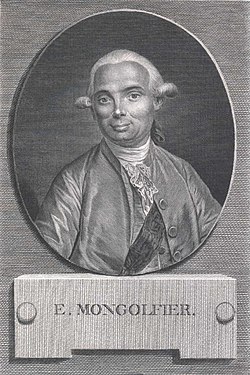Difference between revisions of "AY Honors/Hot Air Balloons/Answer Key"
(fleshed out info on early years) |
(No difference)
|
Revision as of 12:28, 20 April 2006
The Montgolfier brothers, Joseph Michel Montgolfier (August 26, 1740 – June 26, 1810) and Jacques Étienne Montgolfier (January 6, 1745 – August 2, 1799), invented the montgolfière, or hot air balloon. Their invention was the first aircraft to every carry humans into the sky.
Early years
The brothers were born into a family of successful paper manufacturers in Annonay, south of Lyon, France. Their father, Pierre (1700-1793), established his eldest son Raymond (1730-1772) as his successor. As a result, the younger sons were initially sent away to school to learn other professions.
Joseph possessed a typical inventor's temprement -- a maverick and dreamer but impractical in terms of business and personal affairs. Clever and highly inventive by nature, he was rebellious towards his formal education -- twice running away from school. Nonetheless, his natural curiosity led him to a very successful self-education in the then emerging physical sciences. He eventually returned to the family homestead, but was only peripherally involved in the family paper-making business.
Étienne (as Jacques Étienne was more generally known) had a much more even and businesslike temprement than Joseph. He was initially sent to Paris to train as an architect. However, after the sudden and unexpected death of Raymond in 1772, he was recalled to Annonay to run the family business (No serious consideration was given to the elder Joseph in this role given his uneven behaviour.) In the subsequent 10 years, Étienne applied his talent for technical innovation to the family business (papermaking was a high tech industry in the 18th century.) He suceeded in incorporating the latest innovations of the day into the family mills. His work led to recogonition by the government of France and the award of a research grant to foster further development in papermaking.
Initial experiments
When playing with inverted paper bags over open fire they found that the bags rose to the ceiling. This led them to experiment further with larger bags made of other materials. During 1782 they tested indoors with silk and linen.
Public demonstrations
On December 14, 1782 they succeeded in an outdoor launch of an 18 m³ silk bag, which reached an altitude of 250 m.
On June 4, 1783 (many sources incorrectly fix the date as June 5), as a first public demonstration, they sent up at Annonay a 900 m³ linen bag inflated with hot air. Its flight covered 2 km, lasted 10 minutes, and had an estimated altitude of 1600 - 2000 m.
The subsequent test sent up the first living beings in a basket attached to the balloon: a sheep, a duck and a cockerel, to ascertain the effects of the air at higher altitude. This was performed at Versailles, before Louis XVI of France, to gain his permission for a trial human flight.
An ascent in a tethered balloon took place around October 15 (on the 12 or 14 according to Montgolfier), to an altitude of 26 m.
Human flight
On November 21, 1783, the first free flight by humans was made by Pilâtre de Rozier and the marquis d'Arlandes, who flew aloft for 25 minutes about 100 metres above Paris for a distance of nine kilometres.
(A flight by Karl Friedrich Meerwein in 1781 with his "ornithopter", a flapping device, probably preceded this event, but it never became a generally used viable means of flight.)
The ascensions made a sensation. Numerous engravings commemorated the events. Chairs were designed with balloon backs, and mantel clocks were produced in enamel and gilt-bronze replicas set with a dial in the balloon.
Following years
Only one of the brothers (which one is unknown) ever flew in a balloon himself, and then only once.
In 1766, the British scientist Henry Cavendish had discovered hydrogen gas, by adding sulphuric acid to iron, tin, zinc shavings, and hot air balloons were superseded by hydrogen gas balloons. This was followed by further flights, including a crossing of the English Channel on January 7, 1785, by Jean-Pierre Blanchard and John Jeffries. =Rebirth of the hot air balloon=
Balloons using heated air rather than lighter-than-air gasses did not return until the 1960s, when Ed Yost improved the safety of the classic Montgolfier design by using ripstop nylon for the envelope and propane gas as the burner fuel.
External links
- "Lighter than air: the Montgolfier brothers"
- "Balloons and the Montgolfier brothers"
- "Karl Friedrich Meerwein"
de:Montgolfier es:Hermanos Montgolfier fr:Frères Montgolfier io:Montgolfier fratuli he:האחים מונגולפייה nl:Gebroeders Mongolfier ja:モンゴルフィエ兄弟 no:Brødrene Montgolfier pl:Bracia Montgolfier pt:Etiene e Joseph Montgolfier ru:Монгольфье sr:Браћа Монголфје fi:Montgolfierin veljekset sv:Montgolfier zh:孟格菲兄弟

